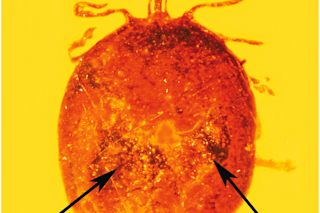A tick preserved in amber, blood from what was likely a primate visible on its back. (Credit: George Poinar, Jr./Oregon State University) Millions of years ago, two primates engaged contentedly in a grooming ritual that is still commonplace today. Searching diligently for pesky ticks and other insects, they cast them to the ground without so much as an afterthought. But one of those ticks would endure after landing in a patch of sticky sap, becoming entombed in amber with blood still flowing from a wound on its back. That's the story that one researcher has pieced together from the body of a tick, gorged with blood, found trapped in amber in the Dominican Republic. The specimen is estimated to be anywhere from 15 to 45 million years old, which would make it the oldest preserved mammalian blood cell specimen. The discovery is all the more exciting given it contains a ...
Tick In Amber Said to Contain Oldest Mammalian Blood Cells Ever Found
Discover the fascinating find of a tick preserved in amber, containing the oldest preserved mammalian blood known to science.
More on Discover
Stay Curious
SubscribeTo The Magazine
Save up to 40% off the cover price when you subscribe to Discover magazine.
Subscribe













